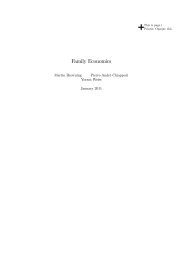Estimation of dynamic linear models in short panels with ... - Cemmap
Estimation of dynamic linear models in short panels with ... - Cemmap
Estimation of dynamic linear models in short panels with ... - Cemmap
Create successful ePaper yourself
Turn your PDF publications into a flip-book with our unique Google optimized e-Paper software.
educes both the <strong>in</strong>fluence <strong>of</strong> <strong>in</strong>itial conditions and the amount <strong>of</strong> data used forestimation. Increas<strong>in</strong>g S also reduces the scale <strong>of</strong> the computational problem. Thissystem is non<strong>l<strong>in</strong>ear</strong> <strong>in</strong> its parameters θ = {α, β, δ, γ, σ u , σ ε , σ η }, where σ ε = 1 <strong>in</strong> thecase <strong>of</strong> observable <strong>in</strong>terval boundaries.3.2 IdentificationConsider the model <strong>with</strong> unobserved grad<strong>in</strong>g thresholds. Partition thecovariates <strong>in</strong>to a common set <strong>of</strong> time-<strong>in</strong>variant variables ζ i and a sequence <strong>of</strong> timevary<strong>in</strong>gcovariates ξ it , so that x it = (ζ i , ξ it ). Assume a full specification <strong>of</strong> the <strong>in</strong>itialcondition (9), so that w i = (ζ i , ξ i1 ... ξ iT ). Make the further assumption that the matrixplim(n -1 ∑w i w i ′) is positive def<strong>in</strong>ite. An ordered probit model for y i0 on w i willconsistently estimate the normed coefficient vector δ/v 0 , where v 2 0 = σ 2 η + γ 2 σ 2 u .Consider equation (27), for any period, t > 0. Rewrite it <strong>in</strong> standardised form:⎛ y⎜⎝ v*ittt⎞ ⎛αv⎟ =⎜⎠ ⎝ vt0t⎞ ⎛ (1 − α ) β⎜⎟ωi+⎠ ⎝ (1 − α)vtζ⎞⎟'ζ⎠i⎛ β+⎜⎝ vξt⎞⎟'ξ⎠it⎛αβ+⎜⎝ vt⎡+ ⎢ctu⎣iξ+⎞⎟'ξ⎠t 1∑ −s=0it−1α εt−1⎛αβ+ ... + ⎜⎝ vtsit−sξt ⎤+ α ηi⎥ / v⎦⎞⎟'ξ⎠ti1(28)where β ′ = (β ζ ′ , β ξ ′ ), v 2 t = c 2 t σ 2 u + (1-α 2t )/(1-α 2 ) + α 2t 2σ η and ω i is the variableδ′w i /v 0 which can be constructed from the coefficients <strong>of</strong> the <strong>in</strong>itial conditions model(22). Rewrite (28) <strong>in</strong> simplified notation as:y*it/ v ω b ξ + υ(29)t= ati+t' ζi+ d0 t' ξit+ d1t' ξit−1+ ... + dt −1,t'i1Note that the covariates (ω i , ζ i , ξ i1 ... ξ it ) are (asymptotically) non-col<strong>l<strong>in</strong>ear</strong>. Thus,ordered probit estimation <strong>of</strong> (29) will generate consistent estimates <strong>of</strong> the scaledcoefficients (a t , b t , d 0t , ..., d t-1,t ). Identification then proceeds as follows. First, thevalue <strong>of</strong> α can be constructed as any element <strong>of</strong> any <strong>of</strong> the vectors <strong>of</strong> ratios d st /d s-1,t . Ifα is zero, the model becomes a static random effects ordered probit, so there is nonew identification issue; we consider the case α ≠ 0 henceforth. With α known, β canitbe <strong>in</strong>ferred up to scale asg / g where g = [b t (1-α)/(1-α t ), d 0t ]. Thus, the keybehavioural parameters α and the direction <strong>of</strong> the vector β are essentially identifiablefrom only two waves <strong>of</strong> the panel.The ratio, R t , <strong>of</strong> a t to α t gives the value v 0 /v t , thus:- 9 -













